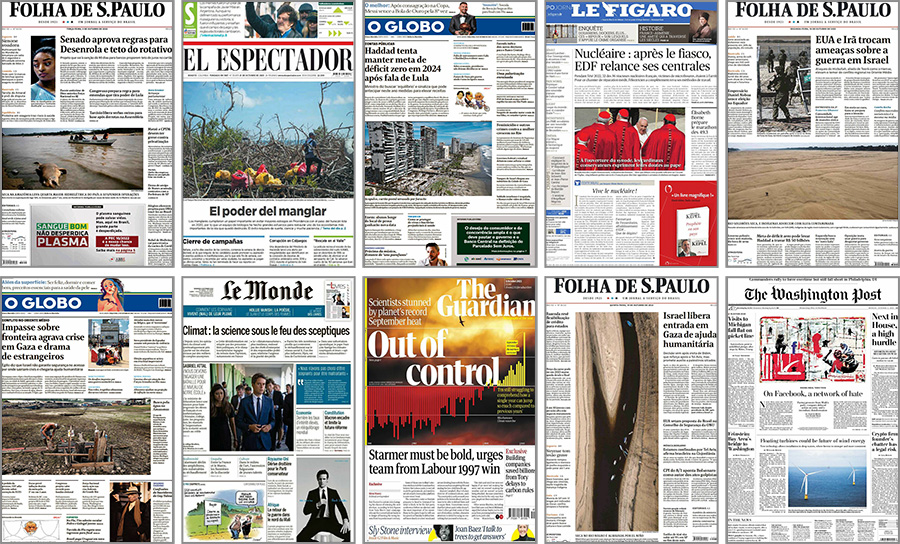11 Mins Read
Even as we breached the 1.5°C post-industrial warming limit and recorded the hottest temperatures ever, 2023 saw media coverage of climate change drop by 4%, according to a review by the Media and Climate Change Observatory.
2023 was a year where we saw increased food shortages around the world, orange skies in North America, floods in New York City, a black rainstorm in Hong Kong, a climate conference helmed by an oil boss with huge positives and huge negatives, as well as record-breaking temperatures.
There was so much to talk about, and yet, we didn’t talk about it enough. A special report by the University of Colorado, Boulder-based Media and Climate Change Observatory (MeCCO), which monitors 131 media sources in 59 countries, has revealed that global climate coverage dropped by 4% in 2023, compared to the year before. It also decreased by 14% from 2021.
Despite all that, 2023 still ranks third among the years with the highest amount of climate change coverage in MeCCO’s 20 years of analysis, with a 33% increase from 2020 levels, and a 4% rise from 2019. Here are the monthly highlights.
January 2023

Newspaper coverage of climate change in January 2023 dropped by 1% from December 2022, but was up by 22% from January 2022. Compared to December, attention was down in down in Asia (-8%), the Middle East (-8%) and Oceania (-16%), and up in the EU (2%), Africa (4%), North America (7%), and Latin America (18%).
The content in the media pertained to the continued extreme weather in North America, a heatwave sweeping across Europe, rain and flooding in California, as well as assessments of extreme weather disasters globally. In terms of cultural stories, there was news of Google sales to clients that spread climate disinformation, plus GHG emissions and potential health dangers associated with gas stoves.
Research articles about US emissions, Exxon, and high temperatures in the UK were also popular, alongside coverage of Sultan Al Jaber’s presidency of COP28 despite being the head of the UAE’s national oil company, and oil and gas company profiteering. Finally, climate change made news at the Davos Forum in January.
February 2023

February saw coverage in newspapers decrease by 15% from January, but it was still up by 14% from 12 months prior. Climate content grew in Oceania by 22%, but was also down in Asia (-5%), Africa (-17%), Latin America (-19%), the EU (-22%), North America (-22%), and the Middle East (-30%).
Among the events that made the headlines were climate events like wildfires in South America, Cyclone Gabrielle in New Zealand, droughts and marine ecosystem destruction in the Mediterranean, record levels of sea ice loss near Antarctica, as well as extreme weather in Somalia. The politicisation of climate investment choices and the EU’s steps towards decarbonisation also gained importance.
March 2023

Globally, media attention about climate change increased by 21% from February to March 2023, and 14% from March 2022. Monthly coverage increased in Asia (12%), Oceania (15%), Latin America (17%), North America (24%), the European Union (EU) (33%), Africa (34%), and the Middle East (106%), as did print coverage in the US (14%).
Heavy rains and flooding in the American West garnered substantial attention, along with Pacific Island nation Vanuatu’s win on persuading the ICJ to rule on national climate obligations, the EU’s greenwashing survey and tech emissions stats, and the Ibero-American climate summit in the Dominican Republic.
Plus, there were discussions about the use of climate change in comedy and fiction, and the IPCC report on global warming grabbed major headlines.
April 2023

Climate coverage in newspapers in April 2023 dipped 12% from the previous month, and 4% from the year before. Month-on-month attention decreased in all regions, by 4% in the European Union and North America, 8% in Asia, 19% in Africa, 23% in both Oceania and the Middle East, and 33% in Latin America.
In terms of content, major subjects included the record-breaking heat across Asia, drought across East Africa, the US EPA’s regulatory action to reduce vehicle emissions, a first-ever drop in fossil fuel use for energy outside a pandemic or recession, and the creation of the US Office of Environmental Justice.
Food shortages across Madagascar also gained attention, just as a study found faster ice-melting in the Arctic than previously detected, and a UN report connected climate change to disaster events and listed records that had been broken, and would continue to be broken again this year.
May 2023

In May, the media paid more attention to climate change than the month before (8%), but less so than May 2022 (-9%). Compared to April, coverage increased in North America (5%), the EU (6%), Oceania (7%), Asia (9%), Africa (30%), and the Middle East (57%), while Latin America was the only region to register a decrease (-1%).
Wildfires in Canada, smoke in the intermountain US western states, and climate policy actions dominated the conversation. In Japan, the G7 meet generated several climate stories, France banned flights that could be replaced with trains, pressure mounted on Al Jaber to step down, and State Farm decided to stop offering home insurance (citing climate risks).
There were also stories about a heatwave in Asia, as well as the Category 5 Cyclone Mocha. More wildfires across Alberta and Nova Scotia in Canada, and a drought in Italy (following floods the month before) caught eyeballs. Plus, many protests and social movements made waves, including at the Met Gala in New York City, Italy and Germany. Then there was a study linking GHG emissions to wildfires in the US, while rising sea temperatures (at their highest since 1982) sounded alarm too.
June 2023

June saw coverage increase 8% from May and 3% from 12 months before, with media content on the rise from the month before in Africa (+5%), the (+8%), Asia (+9%), Latin America (+14%), and North America (+20%), the Middle East (-17.5%) and Oceania (-22%) suffered a dip.
The UNEP agreement to cut plastic pollution, the UN climate negotiations in Bonn, the financial restructuring arrangement meeting in Paris, the sharp rise in private climate adaptation finance, the EU scientific advisory’s proposal to reduce emissions by 90-95% by 2040, more wildfires in Canada, extreme heat in the US and the Middle East, Cyclone Biparjoy in India and Pakistan, and discussions about the human cause of climate change dominated the conversation.
At Amazon, employees walked out in protest of climate inaction, while there was fallout in June for failure to keep carbon neutrality promises at the 2022 FIFA World Cup in Qatar.
July 2023

July’s media coverage of climate change in newspapers around the globe increased by 14% from June 2023, and was also 2% higher than July 2022. Compared to the previous month, coverage surprisingly dipped in North America (-2%), but increased in Asia (+1%), Africa (+2%), Latin America (+8%), Oceania (+12%), the European Union (EU) (+31%), and the Middle East (+115%).
News about heating and flooding was most prominent, with average global temperatures reaching an unofficial record high, and rain and floods sweeping Asia. Additionally, there were stories about ocean warming and climate change, just as record-breaking temperatures continued to dominate the news cycle. More coverage about retreating insurance coverage in the face of climate change made the airwaves, while US climate envoy John Kerry met with Chinese counterparts for three days.
There were instances of further demonstrations, notably Just Stop Oil protests, around the same time that Greta Thunberg was charged with disobeying police after blocking access to an oil facility, and protestors in the US were arrested for disrupting a meeting in a House office building. Teamsters and UPS, meanwhile, agreed to avoid a strike after heat protections were secured for drivers.
In terms of scientific news, there were studies about heat-related deaths, oceans turning greener, how climate change leads to heatwaves, a slowdown in Arctic ocean currents, and how this July was the hottest on record in 120,000 years.
August 2023

Climate coverage dropped by 8% from July and 3% from the year before in August, with monthly news dipping in Africa (-1%), Asia (-8%), the Middle East (-10%), the EU (-15%), and Latin America (-17%). North America (+5%) and Oceania (+21%) were the only regions witnessing increases.
The beginning of the month saw news of flooding in China, Typhoon Doksuri coming on land in Japan, and a heat wave across South Korea, before tragic fires on the Hawaiian island of Maui and wildfires in Canada and Europe generated considerable media attention. August 2023 also saw hurricane activity in North America, while drought impacted shipping through the Panama Canal, students won a landmark climate case in Montana (US), and an Ecuadorian referendum successfully blocked oil drilling in the Chocó Andino rainforest.
Meanwhile, five Greenpeace activists have been arrested after ending their protest on the rooftop of Rishi Sunak’s North Yorkshire mansion, and climate activists spray-painted a superyacht, blocked private jets from taking off and plugged holes in golf courses.
September 2023

In September, media coverage dropped by 1% from the year before, but gained on August by 7%, increasing in the EU (+7%), Asia (+14%), Latin America (+27%), the Middle East (+35%), and Africa (+71%), and decreasing in North America (-12%) and Oceania (-15%).
African leaders met in Nairobi to discuss climate policy action, the UN released its Global Stocktake report, and the UNGA and its associated Climate Week in New York City dominated the news cycle. All this happened as stories about heat records proliferated, and torrential rains and flooding swept the Libyan community of Derna.
There were more protests, with tens of thousands around the world raising their voices against fossil fuels, including outside the UNGA’s meeting in New York. Plus, updated research on “safe operating spaces” for humanity – also called ‘planetary boundaries’ – sparked news attention.
October 2023

There was a larger drop in media coverage in October 2023 – 18% down from the previous year and 22% from September. All regions experienced declines, including Latin America (-7%), Oceania (-14%), Asia (-20%), North America (-24%), the EU (-25%), the Middle East (-26%), and Africa (-26%).
UNICEF published a report about child displacement due to climate change, while a study examined the rapid intensification of Atlantic Ocean storms, and another predicted significant ice sheet loss in Antarctica. One report received even more attention, deep-diving into the current state of Earth’s changing climate in 2023.
There were also droughts and floods in Brazil, Cameroon, France, Vietnam and Myanmar, just as heatwaves and extreme high temperatures continued in places like New Zealand and Hong Kong. Meanwhile, hurricane Otis – a category 5 storm – struck Mexico. The Pope was in the news too, announcing that he planned to attend COP28, labelling climate disasters irreversible, and criticising the fossil fuel industry. A month ahead of COP28, conversations magnified over upcoming decisions needed to achieve a Loss and Damage Fund at the summit.
November 2023

November’s climate coverage had a mix of fortunes – it was up by 21% from the previous month, but down by 41% from the previous year. Compared with the preceding month, coverage increased in Asia (+7%), the EU (+8%), Africa (+21%), North America (+23%), and Oceania (+28%), and dipped in Latin America (-3%) and the Middle East (-21%), which was about to host the COP28 conference.
The UNEP released two reports: one on the Adaptation Gap, another on plans to up fossil fuel production despite climate pledges. Australia announced a residency-as-refuge offer to Tuvaluans due to rising sea levels, the EU emerged with an agreement to regulate and reduce methane emissions, parts of East Africa suffered from flooding, Brazil was the subject of an unprecedented heatwave – which (along with concert venue conditions) brought upon the tragic death of a Taylor Swift fan – and an Oxfam report highlighted carbon inequality and impact of the richest 1%.
There was a trove of climate studies in November too, including the 5th US National Climate Assessment Report, the annual Lancet Countdown on Health and Climate Change assessment, the UN Emissions Gap report, and a finding by the European Copernicus Climate Change Service that revealed the Earth had warmed to 2°C.
December 2023

The first half of December was all about COP28, but it seems the lead-up to the summit generated more media attention than the actual conference, with coverage down by 1% (though it was up by 3% from the previous year). This month saw climate news increase in Asia (+17%), and the EU (+5%), and decline in the Middle East (-3%), Latin America (-8%), Oceania (-10%), North America (-13%), and Africa (-24%) compared to November.
The agreement on the Loss and Damage Fund on day one was hailed across the world, but comments made by Al Jaber disassociating fossil fuels with climate change were met with uproar. A fossil fuel phaseout was the buzzphrase in December, with a reserve day needed to come to an agreement on the matter (which was toned down from the original promise of a full phaseout).
Other stories included California’s lawsuit against the EPA on behalf of young people, major bushfires in Australia, and an emergency in Bolivia due to a lack of water. Plus, scientific studies noted a 1.1% annual increase in GHG emissions in 2023, and the record-high temperatures in the Arctic as well as the world.
There was a lot to unpack last year, but more is needed. Can the media deliver in 2024?



